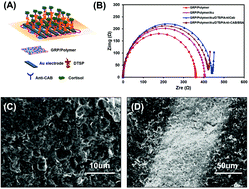Electrochemical-digital immunosensor with enhanced sensitivity for detecting human salivary glucocorticoid hormone†
Abstract
In this work, an ultra-sensitive electrochemical-digital sensor chip is devised for potential use as a digital stress analyzer for point-of-care testing (POCT) and preventive on-site recording of the hormone ‘cortisol’, a glucocorticoid class of steroid hormone present in the human saliva. The sensor was interfaced and re-configured with a high precision impedance converter system (AD5933) and used for electrochemical impedance spectroscopy (EIS) to evaluate the cortisol levels in seven saliva samples. To obtain enhanced biological (cortisol) recognition and achieve a lower limit of detection 0.87 ± 0.12 pg mL−1 (2.4 ± 0.38 pmol mL−1) with a wide range from 1 pg mL−1 to 10 ng mL−1 (2.75 pmol mL−1 to 27.58 pmol mL−1; R2 = 0.9831), bovine serum albumin (1% BSA) was utilized as an effective sensitivity enhancer in addition to optimizing the other two parameters: (i) anti-cortisol antibody (anti-CAb) covalently attached to micro-Au electrodes and (ii) saliva sample incubation time on the sensor chip. The results obtained in this work were corroborated with the gold standard ELISA test with an accuracy of 96.3% and other previously reported biosensors. We envisage that the conceivable standpoint of this study can be a practice towards new development in cortisol biosensing, which will be pertinent to POCT targeted for in vitro psychobiological study on patient cortisol in saliva, and finally an implantable sensor chip in the future.



 Please wait while we load your content...
Please wait while we load your content...